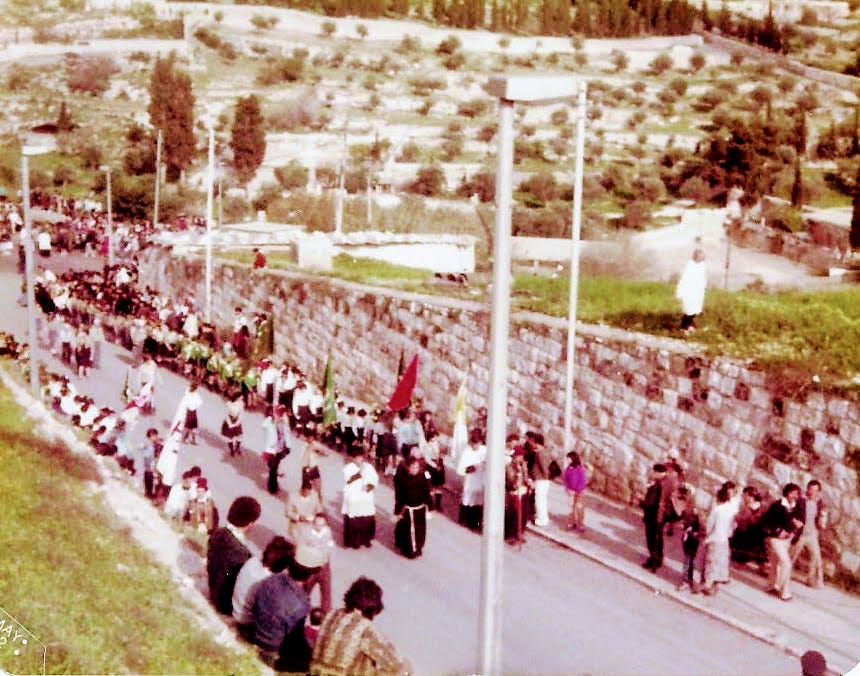Purim and Palm Sunday, Together at Last
For the first time since 1997, Jews and Christians will parade in costume on the same day. celebrating a miraculous delivery from a near-death experience.
Palm Sunday in Jerusalem. I took this photo in 1982, during my rabbinical school year in Israel.
This weekend, in a calendrical rarity, Purim will coincide with Palm Sunday for the first time since 1997, leaving us with the oddest of bedfellows: Easter and Esther, together at last! In Jerusalem on March 24, on one side of town Christians will be parading in costume, celebrating a miraculous delivery from a near-death experience, while all over Israel, Jews…will be doing the same thing (though in Jerusalem Purim is celebrated a day later, but that’s another matter).
It’s simply unnatural. Holy Week should coincide with Passover. That way, Jews and Christians can all celebrate common roots together, sharing interfaith Seders and the annual telecast of “The Ten Commandments.” The stars are usually aligned for this Paschal connection to occur. Easter occurs on the Sunday after the first full moon following the vernal equinox and that full moon usually coincides with the first day of Passover. During Jewish leap years, Passover is pushed back by one lunar cycle and on rare occasions when that happens, Holy Week must contend with Passover’s raucous little sister: Purim.
This year, the natural rhythm has been thrown off completely. While my Christian neighbors will be commemorating the crucifixion, I’ll be participating in a very different sort of passion play, complete with masks and groggers.
Purim is Passover in a fun-house mirror. One is noted for its levity, while the other is completely unleavened. On Purim, boundaries dissolve, as Jews traditionally imbibe until, according to tradition, even good and evil are indistinguishable. On Passover, the theme is not liberation through libation, but rather liberation through intensified structure and discipline; its main meal is even called the “Order” (Seder).
Upon closer examination, Purim and Holy Week are a match made in an unholy heaven. To my knowledge, no one at the Last Supper was asked to pass the hamantaschen. But there are significant associations to be made between the two, and more specifically between the deaths of Haman and Jesus.
Ancient Aramaic versions of the Esther story employ the term tzalab, “crucify,” to describe Haman’s demise. The first-century historian Josephus did as well. While Jews have traditionally ascribed his death to hanging with a noose, historians doubt that such methods of capital punishment were used during that period. In his Sistine Chapel’s interpretation of Haman’s death, Michelangelo emphasized the Christological parallels, depicting a crucifixion rather than a hanging.
For Jews of the Middle Ages, who often suffered under oppressive Christian rule, the parallels between Jesus and Haman were more subtle. While Jews never vilified Jesus himself the way they vilified the genocidal Haman, Purim gave them the opportunity to channel their fears into an annual celebration of epic triumph over an eternal oppressor. The rabbis called that oppressor “Amalek,” noting Haman’s ancestry that is recounted in the book of Esther itself. It is noteworthy that Amalek is introduced in Genesis as the grandchild of Esau, whose Edomite line was linked by post-biblical sages to Rome and later, to Christendom.
No wonder fifth-century Byzantine rulers proscribed the Purim custom of burning Haman’s effigy, suspecting that Jews were trying to satirize Jesus’ death. Just as with the Passion Play, the Purim spiel has carried the potential to incite participants and observers alike toward an intensified hatred of the Other. The most infamous Passion Play is the Oberammergau Passion Play, called by Hitler in 1934 a “precious tool” in his war against the Jews.
It is not coincidental that vicious attacks against Jews have often taken place during the Christian Holy Week — and that one of the most heinous attacks by a Jew, the massacre of 29 Muslims at prayer by Baruch Goldstein in Hebron in 1994, thirty years ago, took place on Purim. Goldstein attended Purim services just before setting out on his infamous mission, undoubtedly drinking up the Megillah’s message of vengeance. Esther is meant to be read as farce, but taken literally, it is perhaps the bloodiest and most chauvinistic book of the entire Bible. The unholy alliance of Purim and Holy Week is an ugly tableau that appeals to the worst instincts of human nature, and that highlights the most dangerous traits embedded in both faith traditions.
Despite it all, Jews and Christians continue to love these two holidays. That’s because, along with all the malice, Palm Sunday and Purim also reveal Judaism and Christianity at their most hopeful. The messianic themes so endemic to Easter are also on display in the Purim story. Echoing a passage from Book of Esther, “These days of Purim will never cease among the Jews.” Jewish tradition proclaims that of all our holidays only Purim will continue to be celebrated in messianic times.
Not Passover. Not Yom Kippur.
Just Purim.
Perhaps in that dreamlike end-time, even the boundaries between Easter and Esther will begin to dissolve and we’ll rally behind all that is good about our fellow human beings, even if we worship the same God differently.
And perhaps this year on Purim, we’ll become more conscious of the tears being shed around us, while at the same time clinging to the hope that laughter ultimately will prevail, for all peoples, on that sunny spring day when hatred dissolves into love and Haman and Mordechai become one.




